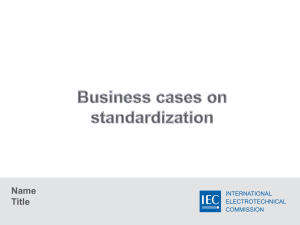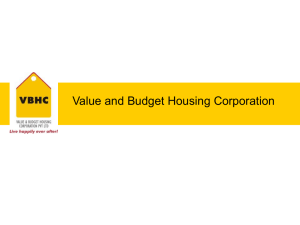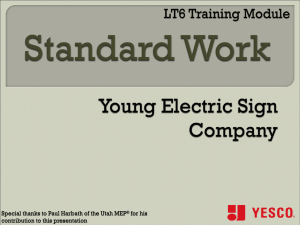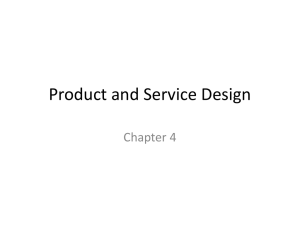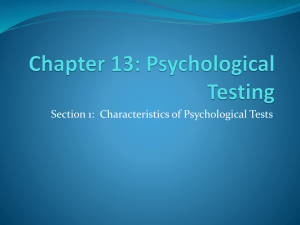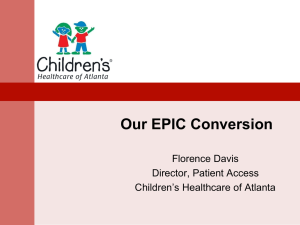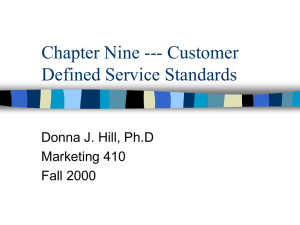Research profiling of `standards and innovation`
advertisement
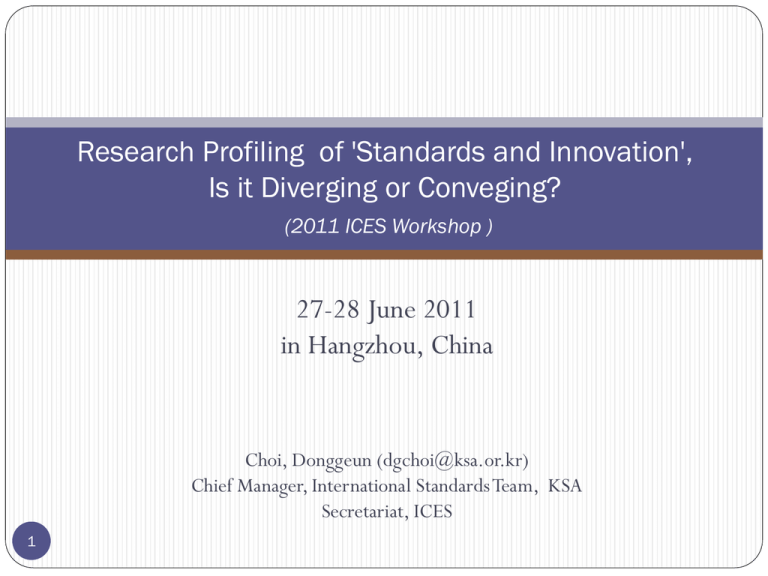
Research Profiling of 'Standards and Innovation', Is it Diverging or Conveging? (2011 ICES Workshop ) 27-28 June 2011 in Hangzhou, China Choi, Donggeun (dgchoi@ksa.or.kr) Chief Manager, International Standards Team, KSA Secretariat, ICES 1 CV: Donggeun Choi Dong-Geun Choi is Chief Manager at Korean Standards Association (KSA). With eleven years of experience in KSA, Dong-Geun ’s research has focused on standardization and innovation, standardization and IPR, and standards education. Dong-Geun initiated and managed several international projects of the International Organization for Standardization (ISO) and the Asia Pacific Economic Cooperation (APEC). Dong-Geun has served as project proponent/editor for APSC SCSC Education Initiatives in 2007-2011, and also served as Secretariat of International Cooperation of Education about Standardization (ICES) in 2009-2011. In these international projects, Dong-Geun authored/edited several policy reports and guidelines: the first joint project between APEC-ISO joint project published as ISO TR 28682:2008, and the APEC SCSC Education Guidelines Series including the textbook about standardization for higher education, “Standardization: Fundamentals, Impact, and Business Strategy”. Dong-Geun received a Bachelor’s degree in transport engineering from Hanyang University, and Master’s degree in transportation management from Seoul National University. He is now a PhD candidate in Technology Innovation and Management at Sungkyunkwan University. Dong-Geun is a Program Committee Member for 2011 ITU-T Kaleidoscope Conference and 2011 IEEE International Conference on Standardisation and Innovation in Information Technology (SIIT) . Donggeun’ academic publications have appeared in such journals as Scientometrics (SSCI), International Journal of Technology and Design Education(SCI-E), International Journals on IT Standards and Standardization Research(Scopus SSCI), and ISO Focus. Summary This presentation includes two sections about standardization and innovation research. Section I includes the review of author’s recently published paper “Research profiling for standardization and innovation” (Choi, Lee & Sung, 2001; Scientometrics 88(1), page 259-278). This paper demonstrates that the standardization and innovation research has continuously grown from publication of 13 papers in 1995 to 68 papers in 2008; the majority of these papers have been published in the six subject group domains of management, economics, environment, chemistry, computer science, and telecommunications. Technology innovation management specialty journals are the most central sources favorable for these themes. We also present an exploratory taxonomy that offers nine topical clusters to demonstrate the contextual structures of standardization and innovation. Section II raises a question to standardization community if the studies on ‘standardization and innovation’ are diverging or converging. Although standardization and Innovation research is clearly emerging, it is not certain if it is converging as an academic discipline. 3 Contents 4 Section I • Reviewing “Research Profiling for Standardization and Innovation” Which topics have been studied in standards and innovation? Section II • Rethinking about the DIVERSITY of ‘Standards’ and ‘Innovation’ Is it converging or diverging topics I. Review of “Research Profiling of Standardization and Innovation This section I includes summary of author’s published paper: “Research profiling of Standardization and Innovation” Choi, Lee & Sung, 2011; Scientometrics 88(1), page 259-278) available at http://www.springerlink.com/content/f5p95542u30u26q0/) 5 Standardisation is a key factor in support of a number of government policies, including competitiveness, innovation, science and technology. Its importance is growing with the globalisation, the convergence of technologies and a growing knowledge economy. The UK Government Public Policy Interest in Standardisation (2009) – DIUS (Department for Innovation, Universities and Skills) 6 1-1. Background - What is the relationship of SI-R? - What strategy/policy should we develop? **SI-R: Standardization and Innovation Research Public Policy Business Strategy Understanding Interrelationship Standardization 7 Innovation 1-2. Results – Subject Domains - Variety of 135 Domains: Management.. 90 82 80 70 60 50 40 30 20 10 0 8 54 46 41 35 30 27 27 26 25 23 21 19 17 16 15 15 15 1-3. Results – Subject Domain Groupings - Major Groups Subject Group Management Environment Economics CS/IS 9 # of Subjects # of Papers 7 Subjects 129 Papers 7 Subjects 79 Papers 2 Subjects 54 Papers 8 Subjects 61 Papers Chemistry 9 Subjects 37 Papers EE/ Telecom Civil/ Transport Law/PA/PS Socio. 3 Subjects 47 Papers 4 Subjects 31 Papers 4 Subjects 31 Papers Subjects Grouped Management; Planning & Development; Business; IE; OR/MS; Eng, Multi; Eng, Industrial; Eng, Manufacturing Env Sci; Env Stu; Eng, Env; Pub/Env/Occ; health; Energy & Fuels; Water Resources; Ecology; Economics; Agricultural Economics CS, Information Systems; CS, Theory & Methods; CS, Software Engineering; CS, Hardware & Architecture; CS, Interdisciplinary Applications; CS, Cybernetics; CS, Artificial Intelligence; Information Science & Library Science Chemistry, Analytical ; Chemistry, Applied; Chemistry, Multidiscipli nary; Chemistry, Physical ; Chemistry, Inorganic & Nuclear; Electro chemistry; Biochemical Research Methods; Biochemistry & Molecu lar Biology; Engineering, Chemical Engineering, Electrical & Electronic;Telecommunications; Commu nication Eng, Civil; Construction and Building; Transport Sci and Technology Law; Sociology; Public Administration; Political Science 1-4. Results – Subject Domain Groupings CAGR in 1997-2008 200 180 160 140 120 100 80 60 40 20 0 16 10 ,8 ,13 20 34 11 5 ,11 ,10 16 22 42 ,10 ,11 8 10 6.Telecom/EE Group 5.Chemmistry Group 4.Computer/Info Group 3.Economics Group 13 18 ,29 ,19 39 57 1997-99 2000-2002 2003-2005 2006-2008 10 Year Block 1. Management Group 1997-99 10 AGR1 30.1% 2000-02 22 AGR2 15.6% 2003-05 34 AGR3 18.8% 2006-08 57 CAGR 21.3% 2.Environment Group 8 26.0% 16 7.7% 20 24.9% 39 19.2% 3.Economics Group 11 -3.1% 10 9.1% 13 13.5% 19 6.3% 4.Computer/Info Group 10 3.2% 11 -10.1% 8 53.6% 29 12.6% 5.Chemmistry Group 2 35.7% 5 26.0% 10 21.6% 18 27.7% 6.Telecom/EE Group 4 40.1% 11 13.3% 16 -6.7% 13 14.0% Six Group Total (354) 45 18.6% 75 10.4% 101 20.1% 175 16.3% Total (532) 70 12.2% 99 10.3% 133 15.1% 203 12.6% 1-5. Results – Subject Domain Groupings - CAGR in 1997-2008 Telecom/EE group grew 40.1% from 1997-99 to 2000-02 • The expansion of mobile communication (Bekkers, Verspagen, & Smits, 2002; Bourreau & Dogan, 2001; Kano, 2000) Chemistry group grew 26.0% from 2000-02 to 2003-05 • Increased interest in biochemistry (M'Barek et al., 2003; Ranalli, Gomes, Delcurat olo, Contento, & Lucera, 2003; Vallance, 2005; Veglio, Esposito, & Reverberi, 200 3). CS/IS group grew 53.6% from 2003-5 to 2006-8, • Diverse factors including consortia standards, open standards in the period (Lee & Percivall, 2008; Lim, 2008; Markus, Steinfield, Wigand, & Minton, 2006). Distilled exemplary researches of each group domain Table 4. 11 1-6. Results – Journals - published more than 5 papers Subject Group Record Count Research policy (RP) 1.Mgt *MOT 13 International journal of technology management (IJTM) 1.Mgt *MOT 7 1.Mgt, 2.Env, 3.Eco 6 1.Mgt 6 1.Mgt *MOT 6 4.CS/IS 6 Technovation (TECH) 1.Mgt *MOT 6 IEEE transactions on engineering management (ITEM) 1.Mgt *MOT 5 Technological forecasting and social change (TFSC) 1.Mgt *MOT 5 Technology analysis & strategic management (TASM) 1.Mgt *MOT 5 4.CS/IS, 6.TEL/EE 5 Water Science and Technology (WST) 2.Env 5 Transportation research record (TRR) Others 5 Source Title Energy policy (EP) Journal of environmental economics and management (JEEM) Journal of product innovation management (JPIM) Lecture notes in computer science (LNCS) Telecommunications policy (TP) 12 1-7. Results – Exploratory Taxonomy - 4 Groups – 9 Clusters - Factor Analysis & Clustering 13 1-8. Results – Exploratory Taxonomy - 4 Groups – 9 Clusters Level 1 Level 2 Descriptions CL1 (60) Inter-relationship of Standardization and Innovation Interrelationship between standardization and inno vation Standards implementation as innovation tool Policy perspective of technological standards and i nnovation CL2 (26) Standards adoption and innovation diffusion (Mode A1 (166) Tech-&Knowledge- D l, Factor, Network) Function/ iffusion/Transfer Standards and knowledge transfer Role CL3 (54) Standardization as an integration tool; Regulatory s Regulation/Integration tandards and innovation on technology-based industry CL4 (26) IPR/Patent/Law 14 Standards and IPR in competitive market Patent, standards, and legal issues 1-8. Results – Exploratory Taxonomy - 4 Groups – 9 Clusters Level 1 A2 (181) Impact /Strategy Level 2 Descriptions CL5 (88) Impact of technology standards in market competition; Impact & Comp Standards, and structure and modeling; etitive Strategy Standardization as business competition strategy CL6 (93) Business development, performance, standards; Business Perfor Standardization for innovation and technological perfor mance mance CL7 (86) Technology development, standards and innovation; Technology & P Technology and product design, standards and innovati roduct on A3 (184) Sector -specific CL8 (63) Qualit Quality assurance and management system standards f y or innovation; & Management Environmental management systems standards System CL9 (35) Service 15 Role of standards in service innovation; Service, network and communication standards 1-10. Epilogue Standards are Diverse in its Definition or Scope Metrology, Industry Standards, Conformity Assessment Agriculture, Building, ICT Technology, Service, QMS, SR Innovation is Varying in its Definition or Scope Launch of new products or process Implementation of new solutions to technological, economical and social problems within an enterprise Rethinking about the nature of Standards & Innovation 16 II. Unsolicited Rethinking about Standards as Knowledge Asset 17 Standards, Perceived Images are Different What ARE standards? What are IN standards? What are standards FOR? What are IMPACT of standards? WHO and HOW should develop and implement standards? HOW should we look at and strategically utilize standards? 18 Diversity of Standards - measurement, tech & non-tech. 19 Diversity of Innovation in different fields (Gamber 2008) The term innovation has been examined by representatives of various fields of study, a number of varying definitions exist in literature. In economics, innovation refers to the technological, social and economic changes. In the field of political economics, innovation is referred to as a first commercial use of improvements, or in other words, the launch of a new product or process onto the market (acc. to [HOTZ-HART, 2001]). From a business management point of view, innovation is the implementation of new solutions to technological, economical and social problems within an enterprise. In this case, innovation is aimed at finding new ways of fulfilling enterprise goals (cf for example [PLESCHAK & SABISCH, 1996]). 20 Standards and Innovation Research - Converging or Diverging? Are the studies on ‘standardization and innovation’ are converging or diverging? Although standardization and Innovation research is clearly emerging, it is not certain if it is converging as an academic discipline. 21
